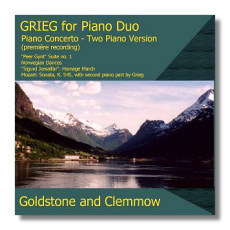
The Internet's Premier Classical Music Source
Related Links
- Grieg Reviews
- Latest Reviews
- More Reviews
-
By Composer
-
Collections
DVD & Blu-ray
Books
Concert Reviews
Articles/Interviews
Software
Audio
Search Amazon
Recommended Links
Site News
 CD Review
CD Review
Edvard Grieg

Music for Piano Duo
- Piano Concerto, Op. 16
- Peer Gynt Suite #1
- Norwegian Dances, Op. 35
- Piano Sonata in C Major, K545
- Homage March, Op. 56 #3
Anthony Goldstone and Caroline Clemmow, pianos
Divine Art 25042 78m DDD
Both the composer and the works recorded on this CD certainly need no introduction. So what makes this music sound so different from the accustomed style we have become so familiar with? As we all know, Grieg was extremely fastidious with detail, and although he is regarded as a miniaturist, the major part of his compositions are vivid tone paintings reflecting both the spirit and the natural wonders of his native Norway. Some of his pieces also inhabit his austere and sometimes brooding character. So it is really no surprise that he arranged a number of his most famous works for piano duet with the objective of making them more transparent and immediate.
All the transcriptions on this disc are by Grieg himself, with the exception of the Piano Concerto where some of the music was arranged by Karoly Thern, an Austro-Hungarian musician of considerable repute. In the hands of Anthony Goldstone and Caroline Clemmow, the music comes through with a "minty" freshness that stimulates and excites and there is hardly any doubt that with more exposure such as this, these pieces can become part of the staple repertoire.
The scholarly annotations are an integral part of this issue as they shed some vital information on why Grieg embarked on this line of composition. The reasons leading the composer to add a second piano part to Mozart's Sonata K. 545 are, to say the least, intriguing.
Copyright © 2007, Gerald Fenech




















